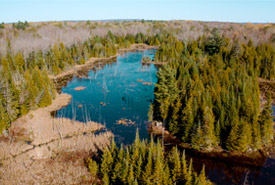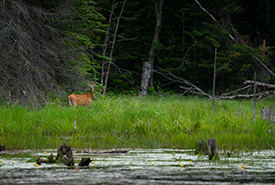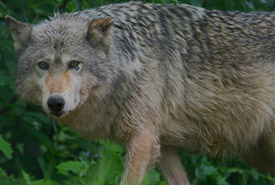Central Ontario Corridors Natural Area

Hastings Wildlife Junction, ON. Photo by Birchbark Media.
Why this place is important
Wildlife corridors between natural habitats are essential for the survival of many species. But across Canada, these corridors are increasingly threatened by roads and habitat loss. The Central Ontario Corridors Natural Area connects several Nature Conservancy of Canada (NCC) natural areas, including Carden Alvar, Rice Lake Plains, Napanee Plain, Frontenac Arch and the Ottawa Valley.
This almost 2.1 million hectare natural area contains a significant corridor of protected lands that run east-west, as well as a portion of the Algonquin to Adirondacks corridor that runs north-south. The vast network of intact forest and wetlands across this landscape will aid in providing a safe passage for a wide range of species.
What NCC is doing
Over 11 per cent of the Central Ontario Corridors Natural Area is formally protected by NCC, the federal or provincial governments, conservation authorities or local land trusts. NCC currently has active large landscape-priority projects within this natural area. Each of these demonstrates the rich biodiversity present in this transitional landscape between southern Ontario and the Canadian Shield. NCC’s long-term vision for the area is to help create a connected mosaic of protected lands across the landscape.

Deer at Hastings Wildlife Junction. (Photo by Chelsea Marcantonio)
Hastings Wildlife Junction
NCC is actively fundraising to protect and care for the Hastings Wildlife Junction, located in the Central Ontario Corridors Natural Area. This 8,000-hectare project is the critical next step to lessen the impacts of climate change and biodiversity loss. The property boasts extensive interior forest with an astonishing 98 per cent natural cover, significant rivers and wetlands. The natural area is adjacent to 30,000 hectares of Crown lands that have been specially designated as enhanced management areas.
What lives there
These are some of the significant and at-risk species found in this natural area:

Eastern wolf (Photo by Manuel Henriques)
Mammals
Insects
Plants
- butternut
- brittle Prickly-pear
- black Ash
Birds
- Canada warbler
- eastern whip-poor-will
- olive-sided flycatcher
Reptiles, amphibians and turtles
Threats
Due to the area’s proximity to the GTA, human development poses an increasing threat as further residential, second home and road development continues to grow. In 2021, Bancroft, the business and recreational hub for North Hastings County, was named the best spot to buy real estate in Canada by MoneySense. These development pressures are fragmenting habitat in the area, making it critical to conserve large, connected areas of protected land.
Partners
The conservation of Central Ontario Corridors Natural Area is not something we can achieve on our own. Only through strong partnerships can this unique area continue to grow and thrive. NCC would like to thank the following partners for their generous support and collective efforts in this natural area:
- Bancroft Field Naturalists
- Haliburton Forest and Wild Life Reserve
- Haliburton Highlands Land Trust
- Harcourt Park
- Land'escpaes
- Ministry of Environment, Conservation and Parks
- Ministry of Natural Resources
- Mississipi Madawaska Land Trust
- Ontario Federation of Anglers and Hunters
- Quinte Conservation
- Quinte Field Naturalists
A priority for conservation
Please consider a gift to help protect and care for the Central Ontario Corridors Natural Area.






